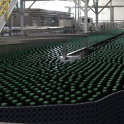|
BDawg posted:I've now brewed 4 batches (kegged 3 of them) from extract kits. For Christmas, I was given a Blichman burner and money to get an all-grain kit. I see at NB, if you buy the kit, it comes with 2 coolers. What's the advantage of using 2 coolers as opposed to 1? The second cooler is most likely to hold your sparge water once you've heated it, so you can re-use the pot to catch the runoff from the mash. The videos you've seen probably use two pots rather than two coolers. I don't think it matters a ton which way you go. Your other question is more of a personal thing. Why do you want to switch to all-grain? If you're just brewing pre-made kits I'm not sure it's worth the effort. For me, I like being able to make up a recipe from scratch and also have full control over the result through variables like mash temperature. There's also the fact that a lot of styles are plain impossible to brew with extract-plus-steeping. I don't think Vienna extract exists, for example. Anything with raw wheat or oats isn't going to work. You can get around it with a partial mash but then you're almost doing all-grain anyway 
|
|
|
|

|
| # ? Jun 6, 2024 09:47 |
|
I don't have the equipment to do all-grain on anything bigger than a 3 gal batch unless it's some pretty low OG beer, but I'm making a Roggenbier/Roggenweizen partial mash. Any thoughts? BIAB stepped infusion mash: 6lb Rye malt 1lb CaraCrystal Wheat Malt 2oz Midnight Wheat Malt Mash in 10qts at 111F 10min at 111F 10min at 131F 60min at 153F Rinse bag with 4 quarts at 180. I'm adjusting the water with a bit of gypsum and CaCl2 to fix low calcium water. 60 min boil: 0.75oz Hallertau at 60min 0.25oz Hallertau at 20min 3lb Light DME (or maybe 3.3lb Munich LME) at 5min Pitching on top of 1-2 day old harvested Safale WB-06. Finishing up a weizen and figured I might as well explore this somewhat unusual style while I had free yeast. baquerd fucked around with this message at 22:58 on Jan 2, 2013 |
|
|
|
It's been 7 years (!!!) since I last brewed in my college apartment, and in the process of moving 4 times, I've lost most of my extract brewing setup. It was poo poo, anyway, and now I'm renting a house with a garage, so I want to get started again. I've made a shopping list of things I need to get, but I want to check and make sure I'm getting the best price for this stuff. Have a look, please? I already have a keg with the top cut off, ready to hold lots of liquid. Keggle kit: weldless bulkhead w/ dip tube($36), valve($13), and thermometer($24.99) from Brew Hardware - $72.99 + $9 shipping Wort chiller: 3/8" x 50' copper tubing coil with solder-on fittings from Copper Tubing Sales - $55.07 + $16.71 shipping Burner: Bayou Classic SP10 - $46.66 at Amazon For a total of $200.43. Considerations: I was not able to find a cheaper price on the chiller anywhere, though if I have to spend $10-$15 more for a pre-assembled coil, I'm not opposed to that. Keggle kits are available everywhere, so if I'm overpaying at Brew Hardware, I won't be surprised. I'm not really sure if I want a thermometer, a sight glass, or both. I can get by without a thermometer, but will I regret not getting a sight glass? Mistaken For Bacon fucked around with this message at 19:33 on Jan 3, 2013 |
|
|
|
So I put my quadrupel into a carboy to age for about a year. I took the dregs and pitched them into an empty 1-gallon carboy, and slapped an airlock on it. This was all about 3 weeks ago. My dumb plan is to add the last 10% of any Belgian dark ales I drink over the next few months into this vessel, and either make another quad that I don't sit on (just for fun) or crank out a Belgian IPA, Saison, or other style that would benefit from an estery profile. Nothing pristine or competition-enterable like that, more an experiment than anything else so I can learn first-hand how older yeast behaves. My question is, do I NEED to refrigerate that carboy? Is it too late to do so? I know yeast are generally resilient creatures but don't know what happens to them when you just block outside air and take away the liquid they're immersed in. I don't care so much about growing the cell count as I do having active, not-lovely yeast when I want to use them.
|
|
|
|
Sirotan posted:Brewed a RR Consecration clone yesterday (the kit that came with the barrel pieces), and tried to actually use my hydrometer for the first time. Except even with the most careful pour of wort into my graduated cylinder, it got all foamy and bubbly on the surface, obscuring my view. This is only my second batch of all-grain beer (using BIAB) and gravity looked to be somewhere between 1.070 and 1.080. Close enough. This is part of the art of making sours (really). You will find conflicting advice as to the best time to pitch the cultures. Jamil recommends fermenting out with regular ale yeasts and then pitching the bugs, but I believe the traditional procedure is to simply pitch the bugs at the beginning. Docjowles posted:The second cooler is most likely to hold your sparge water once you've heated it, so you can re-use the pot to catch the runoff from the mash. The videos you've seen probably use two pots rather than two coolers. I don't think it matters a ton which way you go. Also, to the guy you're quoting: don't buy NB's kit. Buy the coolers yourself and add a bulkhead kit for the coolers (which you can get from NB or wherever). You will save a ton of money this way. Angry Grimace fucked around with this message at 02:20 on Jan 3, 2013 |
|
|
|
Docjowles posted:The second cooler is most likely to hold your sparge water once you've heated it, so you can re-use the pot to catch the runoff from the mash. The videos you've seen probably use two pots rather than two coolers. I don't think it matters a ton which way you go. They say there's more depth of taste with all-grain, even compared to partial mash. At some point in time, I'd like to make my own beer instead of someone else's. For that, I'd have to all-grain. On another note, has anyone tried NB's Innkeeper?
|
|
|
|
I had a really excellent brew day today. It's not even so much that I got good beer out of the deal, although I suspect I did (ask me in a month, or maybe two), but that I reconnected with a long-term brew-pal and that we had a really good time hanging out, having a beer, and making a beer. Even though he and I don't get together nearly as often as we should, it's a solid reminder that beer is about community, and homebrew doubly so.
|
|
|
|
I wanted to derive a formula for calculating beer calories. The details of how I would approach the formula is below. All that is needed is the ABV, the volume of liquid, and the FG. This is not an exact science because density is dependent on temperature, but it should get you pretty darn close! There's a formula here which works similarly and is a ton simpler, but gives lower values in general: http://www.primetab.com/formulas.html I've created a spreadsheet to compare the two if you're interested. You can download a copy (originally created in ods). https://docs.google.com/spreadsheet/ccc?key=0Ak22VYNZFPbWdE1YbWNtTThEY2dTRFFBd3lXQmladGc#gid=0 I would note that if you take the Sc constant below and tweak it to 0.05 / 0.026, the two formulas start to come much closer. This is reasonable, as we can assume there is more other stuff making up the FG than pure carbs and that some of this other stuff is not digestible. I had fun deriving the equations below though! Suppose you have 12fl oz (355ml) of 5% beer at a FG of 1.008. Here's how you could estimate the total calories as a series of simple equations. An in-depth discussion follows. V = 355ml ABV = 0.05 FG = 1.008 g/ml Note: raw numbers below are reference values Av (alc volume) = ABV * V Am (alc mass) = Av * 0.79 g/ml Ac (alc cals) = Am * 6.9 cal/g Ac (simplified) = 5.451 * ABV * V Nv (non-alc volume) = V - Av Tm (total mass) = V * FG Nm (non-alc mass) = Tm - Am Nd (non-alc density) = Nm / Nv Sc (sugar concentration ratio) = 0.05 / 0.018 Ns (non-alc sugar by mass) = Sc * (Nd - 1) Nc (non-alc cals) = Ns * Nm * 4 cal/gram Nc (simplified) = Calories = Nc + Ac Calculating the calories from alcohol 5% ABV means 355ml * 0.05 or 17.75ml alcohol Alcohol's density is 0.79 g/ml, so we have 17.75ml * 0.79 g/ml = 14.02g alcohol Alcohol has 6.9 calories/gram, so we have 6.9 cal/g * 14.02g ~= 97 calories from alcohol. Estimating the other calories We need to figure out the gravity of the liquid were the alcohol not in it. 1.008 gravity of 355ml of liquid means that the liquid is 0.8% heavier than water. Since 355ml water = 355g, 355g * 1.008 = 357.84g for the total weight of the liquid If the alcohol were magically removed, we would have 355ml - 17.75ml = 337.25ml of liquid that weighs 357.84g - 14.02g = 343.82g, giving a density of 1.019g/ml. Now we have a problem because depending on what's dissolved in the liquid, we will have different calibration curves of concentration versus density. This sucks because there's no real way to determine this, but empirically treating it all like it was sugar seems to get us pretty close to real values. So let's assume that everything is similar to sugar in this regard, giving very roughly 5% sugar by mass per 0.018 additional gravity points ( http://www.tiffin.k12.oh.us/userfiles/981/sugar%20content.pdf). x / 0.019 = .05 / 0.018, x / 0.019 = 2.78, or x = 5.28%, meaning that if all the 1.019 gravity points in our non-alcohol solution in fact came from pure sugar, we would have very approximately 343.82g * 0.0528 = 18.15g of sugar at 4cal/gram giving 72 non-alcohol calories. The total calories is then simply 97 + 72 = 169 calories. This matches pretty well with http://www.simplybeer.com/2009/08/19/how-many-calories-are-in-my-beer/ considering a FG of 1.008 is on the low end. If I repeat the calculations with a FG of 1.018, I get: 1.018 * 355g = 361.39g - 14.02g = 347.37g / 337.25ml = 1.030g/ml 2.78 * 0.030 = 8.3% sugar by weight, 30g = 120calories + 97 = 213 total calories Certainly on the high end for a 5% beer, a bit past the high end of the linked chart, but when was the last time you saw a 5% beer at a real 1.018 FG that wasn't a stuck fermentation?
|
|
|
|
Angry Grimace posted:This is part of the art of making sours (really). You will find conflicting advice as to the best time to pitch the cultures. Jamil recommends fermenting out with regular ale yeasts and then pitching the bugs, but I believe the traditional procedure is to simply pitch the bugs at the beginning. Correct. Sours are difficult creatures to replicate. Following a recipe and expecting the same results is nearly impossible which is why major breweries blend multiple barrels/foeders in order to get results they can replicate. I haven't brought a batch to completion yet, but I've brewed 10 sours and I've tried to pitch the bugs in 10 different ways. Having tasted them all at different stages, YMMV for all of them. Pitching straight souring bugs without the Sacch will result in something more tart, funky, and sour. Pitching Roselare or the Lambic blend will not produce strong wild flavors in the first generation of beers. Angry Grimace posted:You can make pretty much anything with partial mashes if you're dead set on avoiding going all-grain. Agreed. Yes, brewing All-Grain gives you many more variables to shape your brew, but it also has more chances for mistakes. Being able to partial mash, I've never felt limited in what I can brew. Also, I can brew in a shorter amount of time and don't require as much equipment. I'll admit that I'm not fussy about exactly replicating my recipes which you would have as a competent All-Grain brewer. BDawg posted:They say there's more depth of taste with all-grain, even compared to partial mash. At some point in time, I'd like to make my own beer instead of someone else's. For that, I'd have to all-grain. Also, the Innkeeper is great. It's nice for its style and turned out very well for me. During a time when I was only brewing IPAs, it was a great lawnmower beer.
|
|
|
|
I think my IPA-sense is dulling. Pretty much every IPA I drink tastes too sweet or not bitter at all. I'm tempted to brew up an IPA with no crystal at all, although I'm worried about ending up with something that tastes like a pinecone.
|
|
|
|
Trying hard not to be that nervous guy making his first homebrew but I need someone experienced to tell me to chill out. As a reminder I'm making a 1.055 OG pale ale with Safale S-04 yeast. I pitched at 80F, Most of primary sat at 70F and now That I've finally gotten the temp of my apartment under control it's been sitting at 60F for the past 2 days. Going by the airlock (I know not always reliable) I had a hell of a primary. roughly 7 hours of getting Krausen in my airlock and having to refill the sanitizer. After I finally got the temp under control the krausen problem seemed to go away and I had just a vigorous constant bubbling at about 14 hours into the fermentation. The next time I checked on it at about 32 hours in, bubbling had slowed to once every 30 seconds or so where it remains today in the low 60s for temp. I'm worried that it seems primary fermentation lasted for less than 48 hours. I'm tempted to take a gravity reading but my brain is telling me to wait at least a week before doing that.
|
|
|
|
Cointelprofessional posted:
I'm not against partial mash, but it seems that recipes are set up for all-grain. How do you convert those to partial mash?
|
|
|
|
S-04 is a beast of a yeast strain and every time I've used it, it finished in 2-3 days. You also pitched warm so that will speed things up as well.
|
|
|
|
ZIGfried posted:Trying hard not to be that nervous guy making his first homebrew but I need someone experienced to tell me to chill out. As a reminder I'm making a 1.055 OG pale ale with Safale S-04 yeast. I pitched at 80F, Most of primary sat at 70F and now That I've finally gotten the temp of my apartment under control it's been sitting at 60F for the past 2 days. You're fine. Given good healthy yeast, a moderate gravity beer like that could certainly be done with the most vigorous activity after 2 days. Listen to your brain and take a reading after a week, I'm sure you'll find it's at a normal FG.
|
|
|
|
Garanimals4Seniors posted:Wort chiller: 3/8" x 50' copper tubing coil with solder-on fittings from Copper Tubing Sales - $55.07 + $16.71 shipping I've been borrowing this exact chiller and plan on getting one of my own as soon as I can. http://www.nybrewsupply.com/wort-chillers/copper-wort-chiller-garden-hose-fittings-12-x-50.html It's wider diameter than what you were looking to do, but not for a lot more money.
|
|
|
|
BDawg posted:I'm not against partial mash, but it seems that recipes are set up for all-grain. How do you convert those to partial mash? You should use a brewing calculator like BrewSmith or Brewer's Friend. Mind the diastatic power ratio, but most recipes have base malt (2-row generally) to spare. Just sub in extract for 2-row. Here's a really basic example: All-grain (off-the-cuff brown ale): 8lb 2-row 1lb Caramel 90L 8oz Chocolate Partial mash: 1lb 2-row 1lb Caramel 90L 8oz Chocolate 4.75lb Light DME
|
|
|
|
BDawg posted:I'm not against partial mash, but it seems that recipes are set up for all-grain. How do you convert those to partial mash? Basically you would just take out some of the base grain from the recipe and replace those gravity points with the correct amount of extract. So let's say for example you have a simple all grain oatmeal stout recipe that is: 8.5 lbs maris otter 1 lb roasted barley .5 lb flaked oats I'm using beer calculus for these numbers and it gives me an OG of 1.056. When I used to do partial mash I could mash 4 lbs of grain total, and to get your flaked oats to contribute anything you need to have some base malt in there. So for this recipe you can mash your 1 lb roasted barley, your .5 lb flaked oats and that leaves you mashing 2.5 lbs maris otter. So now our recipe looks like: 2.5 lbs maris otter 1 lb roasted barley .5 lb flaked oats This gives us an OG of 1.022 so you need to make up .034 gravity points to hit the target OG of 1.056. So now you just go to your recipe design software and add extract back until you hit that. Our final recipe would look like: 5 lbs extra light liquid extract 2.5 lbs maris otter 1 lb roasted barley .5 lb flaked oats Edit: beaten but I have numbers and my beer would be better
|
|
|
|
I was reading on another forum that it's near impossible to overpitch yeast, one guy said that you'd need a gallon of yeast slurry before you'd overpitch for a 5 gallon batch. I am guessing that's hyperbole, but is there any validity? I'm wondering because I bought 2 packets of a Wyeast smack pack manufactured in April, Mr. Malty recommended a 1.3 liter starter with 7 packets. Instead I did the 2 packets in an 800ml starter, waited 3 days, decanted, and made a 1,300ml starter. I'm just worried I'm overpitching. Thoughts?
|
|
|
|
You're not overpitching, for most average gravity beers you can do a 2L starter with a fresh pack/vial of yeast and it's a "preferred" amount of yeast for the likes of Mr. Malty. You pretty much have to be trying to overpitch on a homebrew scale to actually do it. The only way I think people generally overpitch on a homebrew scale is using the entire yeast cake from a previous beer for another moderate gravity beer. Even then you generally just get less yeast character than you generally would, it doesn't really lead to off flavors until you're massively overpitching. I do a lot of belgian and english beers so I worry a little more about overpitching just because I'm looking for more esters and yeast character and I still do a 1.5L starter when I make one.
|
|
|
|
So if you're not shooting for any yeast flavor (hoppy American ales/hybrid styles/lagers/etc) overpitching is not of any concern?
|
|
|
|
internet celebrity posted:So if you're not shooting for any yeast flavor (hoppy American ales/hybrid styles/lagers/etc) overpitching is not of any concern? I would not say that. I have made beer that just seemed to be missing something by racking onto a fresh yeast cake. Yeast character was not my goal, but the beer just seemed bland. I think overpitching can be done and can be detrimental even if you're not trying for a yeast-forward beer. But it would be hard to do with just a starter; you'd have to pitch a pint of live slurry or something to get there.
|
|
|
|
I've got a fermentation that just won't loving stop. Brewed it 3 weeks ago today. up until the 29th the airlock was bubbling once every two seconds, which finally started slowing. This morning it was once per 6 seconds. This is WAAAAAAAAAAAAAAAAAY longer than I've ever seen one go (though experience is limited). Anyone ever see something like this?
|
|
|
|
Paladine_PSoT posted:Anyone ever see something like this? Yeah, it's not all that unusual. Just as lack of airlock activity does not necessarily mean that the ferment has finished, the presence of airlock activity does not necessarily mean it is still going on - it could just be gas coming out out of solution. The only way to know for sure is to pull successive gravity samples.
|
|
|
|
Jo3sh posted:Yeah, it's not all that unusual. Just as lack of airlock activity does not necessarily mean that the ferment has finished, the presence of airlock activity does not necessarily mean it is still going on - it could just be gas coming out out of solution. It seems... unsafe to bottle if it's just releasing trapped craploads of gas. Racking it to the bottling bucket seems like that would at least help let some escape, but how would I make sure it's safe to bottle?
|
|
|
|
Pull samples a couple of days apart and measure the specific gravity. If the gravity is both where you expect it to be and not changing, you're good to bottle. if it's still dropping, leave it another week and try again. EDIT to add: If the ferment is done and the airlock bubbling is caused by gas coming out of solution, you're still safe to bottle. The amount of actual dissolved gas at atmospheric pressure and ferment temps is tiny compared to the amount you will add by priming. Jo3sh fucked around with this message at 18:51 on Jan 3, 2013 |
|
|
|
Jo3sh posted:Pull samples a couple of days apart and measure the specific gravity. If the gravity is both where you expect it to be and not changing, you're good to bottle. if it's still dropping, leave it another week and try again. Right, but doesn't the continued bubbling without a change in gravity indicate that there's more than 1 volume CO2 hanging out in there which would throw off my carbonating calculation and result in bottle bombs?
|
|
|
|
It will change the total amount of gas some, yes, but not nearly enough to make bombs. Probably not even enough to be noticeable.
|
|
|
|
Wyeast 1388 Strong Ale Yeast will keep bubbling at a steady pace for months. Both times I've used it has been for imperial stouts which I've let go for months before even thinking about packaging so I wasn't checking the gravity.
|
|
|
|
Paladine_PSoT posted:It seems... unsafe to bottle if it's just releasing trapped craploads of gas. Racking it to the bottling bucket seems like that would at least help let some escape, but how would I make sure it's safe to bottle? My last beer had US-05 in it, which I use for almost everything, and instead of knocking out the fermentation in less than a week, it took about 3 weeks for the gravity to level out and the krausen to go down. It does seem to happen - I wouldn't sweat it too much, just let it do its thing and take some gravity readings.
|
|
|
|
baquerd posted:You should use a brewing calculator like BrewSmith or Brewer's Friend. Mind the diastatic power ratio, but most recipes have base malt (2-row generally) to spare. Just sub in extract for 2-row. Will BrewSmith tell you what temperatures to mash or do you just put it in your water until you hit 170 like if you were extract brewing?
|
|
|
|
BrewSmith can calculate the strikewater amount and temperature based on the mash schedule, type, and equipment you put in.
|
|
|
|
Josh Wow posted:You're not overpitching, for most average gravity beers you can do a 2L starter with a fresh pack/vial of yeast and it's a "preferred" amount of yeast for the likes of Mr. Malty. You pretty much have to be trying to overpitch on a homebrew scale to actually do it. The only way I think people generally overpitch on a homebrew scale is using the entire yeast cake from a previous beer for another moderate gravity beer. Even then you generally just get less yeast character than you generally would, it doesn't really lead to off flavors until you're massively overpitching. I do a lot of belgian and english beers so I worry a little more about overpitching just because I'm looking for more esters and yeast character and I still do a 1.5L starter when I make one. Again you've eased my concerns, thanks! Brewing now, the Forbidden Fruit yeast smells excellent in the starter. I was reading and some say it's the original Peter Celis Hoegaarden strain, so I'm excited for that. One brew day mishap though, somehow Hopville was set for 0.75 qt/lb of water for the mash. After adding everything to the water I instantly knew something was wrong, I mixed it til it was oatmeal while we got water up to a quick 153 (the mash was sitting at 155), and it's been sitting at 150-151 now so I'm guessing it'll be okay, but I really wish it were closer to 152 since I wanted a little more body in the witbier, but I don't think it'll be too noticeable. As for Brewsmith, I found Hopville a lot easier to use.
|
|
|
|
GORDON posted:I just made my 12th batch, a Porter from a Brewer's Best kit. Up until now, I have always transferred my beer to a secondary fermenter after a few days in primary. Follow up to this: I bottled the beer at about 15 days, and the only thing I noticed at the time was that a handful of chunks of trub ended up getting sucked through the siphon into my bottling bucket, and therefore into some of the bottles as I mixed it up with the priming sugar. Gravity was about .02 points above my range, but I just let it go. I always figure a tad bit more fermentation happens after bottling, anyway. That usually gets settled out during secondary, so I never had to deal with it before. SO far there have been no issues... and, this was one of my most popular beers at the Christmas party. Usually just I and one or two of the beer drinkers have a small glass, but this time everyone was really positive about the Holiday Spiced Porter. So, in summary, no issues with 15 days in primary with no secondary.
|
|
|
|
Midorka posted:As for Brewsmith, I found Hopville a lot easier to use. Dudeman who created Brewsmith needs to hire someone to do a complete UI rehaul. I use it to create recipes and it's great, but do I really need four place to find the god drat 'tools'? I know this has been said a million times before, but I feel it bears repeating. The UI on the mobile app is decent, why so poo poo on desktop?
|
|
|
|
Ok, this is driving me nuts
|
|
|
|
I was using BeerSmith today working out a stout recipe. I added all the ingredients, adjusted the prices, added a couple new grains my beerstore had (they were out of almost all varieties of chocolate malt, WTF), toyed with the recipe to get it where I wanted it, set up the mash schedule, was adding some notes and hit Ctrl-Z. The recipe disappeared and I had to start from scratch again. Seriously, who makes the first level of undo in a textbox to be "undo creating this recipe"? If hopville adds a better way to print the recipe, shut up and take my money! I'm so pleased my pipeline is full now. I've got a porter and a pale ale in kegs and on tap, a red ale cold crashing, and brewing a stout on Saturday. There are so many different things I want to try in recipes, I am beginning to wonder if I should just start a speakeasy to help clear out space.
|
|
|
|
Holy cow I didn't even realize I wrote brewsmith, whoops. As for brewing without an immersion chiller, gently caress that. I've gotten so used to brewing with one that I'll never brew without one again.
|
|
|
|
CapnBry posted:I was using BeerSmith today working out a stout recipe. I added all the ingredients, adjusted the prices, added a couple new grains my beerstore had (they were out of almost all varieties of chocolate malt, WTF), toyed with the recipe to get it where I wanted it, set up the mash schedule, was adding some notes and hit Ctrl-Z. The recipe disappeared and I had to start from scratch again. Seriously, who makes the first level of undo in a textbox to be "undo creating this recipe"? This is my IT geek side kicking in, but two things. 1. Go to beersmith.com and make sure you have the latest version. In the early builds of BeerSmith 2.0 the Check for Updates feature was broken ( 2. If you are on the latest version, make a quick post on his bug report forum. I've found Brad to be super responsive to constructive suggestions and bug reports. He's made several changes in direct response to things I posted on his forum. Even UI issues! Although apparently "dude you need to nuke it from orbit and start over" was not specific enough 
Docjowles fucked around with this message at 05:48 on Jan 4, 2013 |
|
|
|
GORDON posted:Follow up to this: I think your question has a complex answer; namely that bulk conditioning time is dependent on the beer's "depth", ABV, and desirability of yeast phenolics and esters. I would happily bottle a hefeweizen at 7 days if fermentation is complete, but an imperial stout will sit for at least a month. Note that bottle conditioning is not dissimilar to bulk conditioning in primary; it's just slower.
|
|
|
|

|
| # ? Jun 6, 2024 09:47 |
|
Docjowles posted:Ok, this is driving me nuts Hahahah, I had the program open and the webpage pulled up and still somehow missed that. Oy Vay. I dunno if my Secret Santa wanted tasting notes, but I did them anyway. Mostly because I want to know more about the sour.  One Year Aged Belgian Abbey Strong dark cherries, not overly sweet, no noticeable hop at all, STRONG tasting but not boozy. Really nice winter-time brew.  Pale Belgian Sour Ale Strong 'sour' nose, even smelled it when pouring. Palate changes fast, 1st - Sweettart sweet/acid, 2nd - A splash of barn/farm funk, 3rd - a mellow residual sweetness that lingers. VERY tart. Oh so good. I'd love to brew this one myself - recipe/notes?  Munich Dunkel Pretty much nothing but smooth roast in the head/nose. Very clean. Chocolaty thick mouthfeel but somehow not so "dense" (if that makes any sense at all). Quite drinkable. Overall a really great three beers, thanks Santa.
|
|
|

























